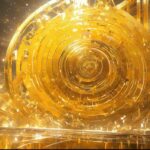Copper, the Versatile Wonder: Discover Fun Facts! Delve into the captivating world of copper, a remarkable metal that has been utilized by humans for over 10,000 years. Not only is copper highly versatile and essential to countless industries, but it also possesses extraordinary properties that make it naturally antibacterial. In fact, copper’s antimicrobial properties are so impressive that a time capsule containing samples of this wonder element was sent into space, representing our planet’s diversity and resilience. Furthermore, copper plays a crucial role in preventing the attachment of barnacles to ships, ensuring smooth sailing for these majestic vessels. Get ready to be amazed by the enticing and informative fun facts we have in store for you!

Key Takeaways:
1. Copper has a unique reddish-metallic color, similar only to gold among all elements.
2. Copper, along with gold and meteoritic iron, was the first metal ever used by humans over 10,000 years ago.
3. Copper is the third most consumed metal in the world, and it is completely recyclable without losing its properties.
4. The Statue of Liberty is made from 179,000 pounds of copper, and the average home contains 400 pounds of copper.
5. Professional chefs prefer cooking with copper pots and pans because of its even heat distribution and lack of hot spots.
6. Copper is naturally antibacterial and has the ability to kill germs on contact.
Fun Facts about Copper
Copper, a versatile and awe-inspiring element, holds a myriad of fascinating secrets. Let’s delve into some fun facts about copper that will leave you astounded and hungry for more knowledge about this remarkable metal.
1. Unique Reddish-Metallic Coloring
Copper boasts a distinct reddish-metallic coloring, making it stand out among all the elements, except for gold. Its vibrant hue adds an aesthetic appeal to various applications, from decorative art to architectural designs.
2. Early Use by Humans
Copper holds the honor of being one of the first metals to be worked by humans. Alongside gold and meteoritic iron, copper was utilized a staggering 10,000 years ago. The ancient civilizations forged copper into tools, weapons, and ornaments, marking a significant milestone in our human history.
3. Third Most Consumed Metal in the World
With its remarkable properties and versatile applications, it’s no surprise that copper ranks as the third most consumed metal worldwide. From electrical wiring to plumbing systems, this metal’s exceptional conductivity and malleability make it indispensable in various industries.
4. Infinite Recyclability
One of copper’s remarkable attributes is its purely recyclable nature. Recycling copper doesn’t result in any loss of its essential properties, thus making it an incredibly sustainable and environmentally friendly choice. By opting for copper recycling, we contribute to reducing waste and conserving the Earth’s valuable resources.
5. The Statue of Liberty’s Copper Legacy
Did you know that the iconic Statue of Liberty is not just a symbol of freedom but also a testament to copper’s resilience? This colossal structure is made from a whopping 179,000 pounds of copper, which has gracefully weathered over time, developing its characteristic green patina.
6. Copper’s Presence in Our Homes
If you think you’re far from copper’s influence, take a closer look around your home. On average, a typical household contains around 400 pounds of copper, quietly working its magic in electrical wiring, plumbing systems, and various appliances.
7. Chefs’ Preferred Cooking Companion
Professional chefs around the world appreciate copper’s exceptional properties in the kitchen. Copper pots and pans offer uniform heat distribution, ensuring even cooking without any pesky hot spots. So, the next time you savor a delicious meal prepared by a skilled chef, you can thank copper for its culinary contribution.
8. Natural Antibacterial Powers
Beyond its formidable versatility, copper possesses a remarkable antibacterial edge. It has inherent properties that make it naturally antibacterial, capable of killing germs on contact. This attribute has made copper an ideal material for various applications, from medical equipment to antimicrobial surfaces.
In conclusion, copper is not just a metal; it’s a versatile wonder with a rich history and remarkable properties. From its intriguing reddish-metallic coloring to its infinite recyclability and antibacterial powers, copper continues to shape our lives in countless ways. So, the next time you encounter copper, take a moment to appreciate its marvels and the crucial role it plays in our world.
Fun Facts about Copper: Unique reddish-metallic coloring, early use by humans, third most consumed metal in the world, purely recyclable, Statue of Liberty’s copper legacy, copper’s presence in our homes, chefs’ preferred cooking companion, natural antibacterial powers.
Check out this fascinating fun fact about protein! fun fact about protein
Discover some interesting fun facts about fishing! fun facts about fishing
Learn amazing fun facts about Mae Jemison, the first African-American woman to travel in space! fun facts about Mae Jemison
Uncover intriguing fun facts about Raphael, one of the most renowned painters of the Italian Renaissance! fun facts about Raphael
Explore surprising fun facts about beer, one of the oldest and most widely consumed alcoholic beverages! fun facts about beer
A copper time capsule of our planet was sent into space
Copper, the versatile metal that has been shaping our history for thousands of years, holds yet another intriguing fact. In 1977, as part of the Voyager mission, NASA sent a copper time capsule into space. This extraordinary event aimed to capture a glimpse of our civilization and share it with potential extraterrestrial life forms. The copper time capsule contained a collection of sounds, images, and greetings from Earth, serving as a representation of our curiosity and exploration beyond our planet.
While the main purpose of the mission was to study outer space, the inclusion of a copper time capsule highlights the significance of this metal in human history. Copper, with its exceptional conductivity and durability, was chosen as the material to encapsulate our memories and mark our presence in the vastness of space. It is a testament to the enduring nature of copper and its ability to withstand the test of time and space.
This remarkable endeavor showcases the inventive and imaginative ways in which copper continues to be utilized. From its ancient origins to its journey into the unknown realms of space, copper remains an invaluable part of our lives and contributes to our understanding of the universe.
Key Takeaways:
– In 1977, NASA sent a copper time capsule into space as part of the Voyager mission.
– The copper time capsule contained sounds, images, and greetings from Earth.
– It serves as a representation of humanity’s curiosity and exploration beyond our planet.
– The use of copper in the time capsule demonstrates its historical significance and endurance.
– Copper continues to be a versatile and remarkable metal, shaping our past, present, and future.
References
[^1]: Discover Walks. (n.d.). 15 Interesting Facts About Copper. Retrieved from
4. Copper Prevents Barnacles from Attaching to Ships
Copper, with its remarkable properties, plays a crucial role in preventing the attachment of barnacles to ships. These tiny, crustacean-like shellfish can cause significant damage to ships, leading to increased maintenance costs and reduced efficiency. But how does copper effectively keep barnacles at bay?
The Pioneering Solution: Copper Sheathing on Ship Hulls
In the 18th century, the Royal Navy revolutionized shipbuilding by developing copper sheathing for ship hulls. This innovative technique involved covering the bottom of ships with copper sheets, creating a protective barrier against marine organisms. Copper’s unique characteristics make it a formidable deterrent against barnacles and other sea life.
Toxicity to Invertebrates: Barnacles Beware
Copper is toxic to invertebrates, including barnacles. When these marine creatures come into contact with copper, it disrupts their vital functions, preventing them from attaching to the ship’s hull. This reliable defense mechanism eliminates the risks posed by barnacles, as they can cause leaks and rot in ship timber, affecting the integrity of maritime vessels.
A Natural Barrier Against Attachment
Barnacles, floating in water currents, search for suitable surfaces to settle on and begin their growth. However, copper acts as a natural deterrent. Its toxicity interferes with the attachment process, making it extremely challenging for barnacles to anchor themselves onto copper-sheathed ships.
Overcoming the Limitations
While copper presents a formidable defense against barnacles, it’s important to note that even the most toxic copper paints cannot completely prevent all growth all the time. However, copper’s effectiveness in minimizing barnacle attachment is significant. It substantially reduces maintenance efforts and the need for additional antifouling coatings, ensuring easier navigation and prolonging the lifespan of ships.
Beyond Barnacles: Additional Benefits
Copper’s antifouling properties extend beyond barnacle prevention. The copper-nickel cladding used on ship hulls eliminates the need for special antifouling coatings, preventing biofouling caused by other marine organisms like algae and mussels. This not only reduces drag, fuel consumption, and carbon emissions but also saves the shipping industry billions of dollars in fouling and maintenance costs.
Key Takeaways:
- Copper sheathing on ship hulls pioneered by the Royal Navy prevents the attachment of barnacles and other marine organisms.
- Copper’s toxicity to invertebrates, including barnacles, disrupts their vital functions and prevents attachment to ships.
- Copper acts as a natural barrier, making it extremely challenging for barnacles to anchor themselves onto copper-sheathed ships.
- While copper paints cannot completely prevent all barnacle growth, they significantly minimize attachment, reducing maintenance efforts.
- Copper-nickel cladding eliminates the need for additional antifouling coatings, preventing biofouling by algae and mussels, and decreasing fuel consumption and carbon emissions in the shipping industry.
Sources:
– Brunel: Five intriguing facts about copper
– My Cruiser Life: Barnacles on Boats – Why & How to Prevent Them

FAQ
Q1: How long have humans been using copper?
A1: Humans have been using copper for at least 10,000 years. It was one of the first metals to be worked by man, along with gold and meteoritic iron.
Q2: Is copper naturally antibacterial?
A2: Yes, copper possesses a natural antibacterial property. It has been observed that copper surfaces can eliminate various types of bacteria, making it a valuable material for objects such as doorknobs, handles, and hospital equipment.
Q3: Was a copper time capsule sent into space?
A3: Yes, in 1977, NASA sent a copper time capsule into space as part of the Voyager mission. The capsule contained a collection of sounds, images, and greetings from Earth, serving as a snapshot of human civilization for potential extraterrestrial life.
Q4: How does copper prevent barnacles from attaching to ships?
A4: Copper is used to prevent barnacles from attaching to the hulls of ships. The protective property of copper deters the growth of barnacles and other marine organisms, reducing maintenance costs and enhancing ship efficiency.
Q5: What is the significance of the green patina on the Statue of Liberty?
A5: The green patina on the Statue of Liberty is caused by oxidized copper. Over time, exposure to the elements has given the copper statue its distinctive green color, known as verdigris, symbolizing the enduring nature of copper.
- SYBAU See You Baby Meaning: Gen Z Slang Evolves - July 1, 2025
- Unlock Your Inner Youth: Lifestyle Secrets for a Vibrant Life - July 1, 2025
- Decode SYBAU Meaning: Gen Z Slang Explained - July 1, 2025






